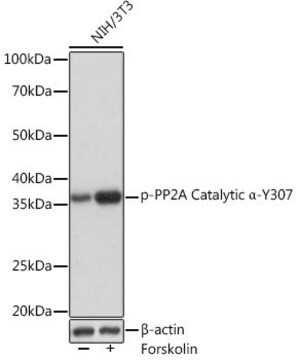04-1479
Anti-methyl-PP2A Antibody, C subunit, clone 2A10
clone 2A10, from mouse
Synonyme(s) :
Anti-NEDLBA, Anti-PP2Ac, Anti-PP2CA, Anti-PP2Calpha, Anti-RP-C
About This Item
Produits recommandés
Source biologique
mouse
Niveau de qualité
Forme d'anticorps
purified antibody
Type de produit anticorps
primary antibodies
Clone
2A10, monoclonal
Espèces réactives
yeast, human, Saccharomyces cerevisiae, mouse
Réactivité de l'espèce (prédite par homologie)
rat, rabbit, chicken, pig, Drosophila
Technique(s)
western blot: suitable
Isotype
IgG1κ
Numéro d'accès NCBI
Numéro d'accès UniProt
Conditions d'expédition
wet ice
Modification post-traductionnelle de la cible
methylation (Leu309)
Informations sur le gène
human ... PPP2CA(5515)
Description générale
Spécificité
Immunogène
Application
Signaling
Transcription Factors
Qualité
Western Blot Analysis: 1-5 µg/mL of this antibody detected the methylated form of PP2A catalytic subunit in yeast lysates lacking the methylestrase (increased methylation). Treatment of the blot with 0.2 M NaOH will demethylate proteins, thus eliminating detection of PP2A.
Description de la cible
Liaison
Forme physique
Stockage et stabilité
Remarque sur l'analyse
Lysates from a yeast wild type strain (strain lacking the methyltransferase, delta PPM1) and a strain lacking the methylestrase, delta PPE1.
Autres remarques
Clause de non-responsabilité
Vous ne trouvez pas le bon produit ?
Essayez notre Outil de sélection de produits.
Code de la classe de stockage
12 - Non Combustible Liquids
Classe de danger pour l'eau (WGK)
WGK 1
Point d'éclair (°F)
Not applicable
Point d'éclair (°C)
Not applicable
Certificats d'analyse (COA)
Recherchez un Certificats d'analyse (COA) en saisissant le numéro de lot du produit. Les numéros de lot figurent sur l'étiquette du produit après les mots "Lot" ou "Batch".
Déjà en possession de ce produit ?
Retrouvez la documentation relative aux produits que vous avez récemment achetés dans la Bibliothèque de documents.
Notre équipe de scientifiques dispose d'une expérience dans tous les secteurs de la recherche, notamment en sciences de la vie, science des matériaux, synthèse chimique, chromatographie, analyse et dans de nombreux autres domaines..
Contacter notre Service technique








